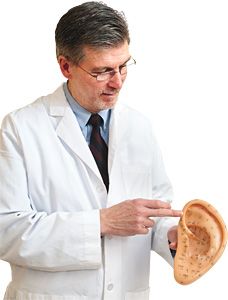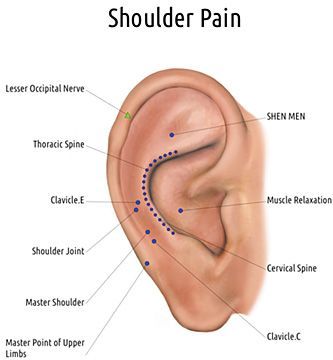Whether you accept it, avoid it or live somewhere in between, insurance coverage has become a defining issue for our profession. Patients increasingly expect to use their benefits, practitioners want to be compensated fairly for their time and expertise, and the system itself remains – at best – fragmented. The encouraging news is that coverage has expanded in meaningful ways. The challenging news is that reimbursement, across the board, remains inadequate.
What is the Point of Auriculotherapy?
Do you remember your first auriculotherapy course from college?
Mine was very short—only about 28 hours. I learned just enough to get by. In fact, when I was done, there were a few key points that I had memorized; Shen Men, Point Zero, Brain 'for pain' and the TCM related organ points were my arsenal. I was taught that auriculotherapy could be very effective, but they only taught me enough in school to pass the exams. So, I settled with using the basics, and that was it.
Once I began my own practice, I decided that I wanted to dig deeper into the subject of auriculotherapy. Have you ever tried looking up points and protocols for auricular acupuncture? There are more than 300 points on the ear, every ear is different and most of the reference charts vary to some degree. There are also multiple theories of auriculotherapy and each theory has differing point locations. Ear charts and point locations are created according to the author's experience and their own artistic representation of the ear. While trying to sift through a mountain of information, I would often sit with piles and piles of books on my desk and sticky notes overflowing from all directions, trying to find the perfect set of points to treat my patients.

After two years of deep research and cross referencing an array of auriculotherapy books and resources—I have learned that, as promised in school, auriculotherapy can be very effective—especially in the treatment of chronic pain. Now, I use it with every patient. I teach other practitioners how to successfully utilize it in their clinics and my patients get better faster.
The biggest problem is knowing which points to use and then finding the most effective way to treat them. I would like to share resources for helping you to choose the best auricular points, treatment tools that I have found helpful and my favorite treatment protocol and technique for treating chronic shoulder pain.
Resources for finding the best auricular points
When I was in school, if I was going to use auriculotherapy as a treatment modality for a patient, I spent my time with a group of students standing around the big chart in the hall trying to find the right points to use. Then, I hurried into the treatment room trying not to forget the location for the points I had chosen. You can probably relate to my experience.
Fortunately, those days are behind us. Technology has really caught up with the ancient art of acupuncture and there are a number of technical applications for smart phones, tablets and the PC that make deciding which points to use very easy. I recently spent several months collaborating on the Auriculo 3D project to develop new, three-dimensional auriculotherapy software that shows auricular points on a movable, three-dimensional ear in real time. With this advancement, the days of auricular guesswork are over.
Google the words: "auriculotherapy reference tools" and you will find some really great resources. When deciding which tool is best for you, consider whether or not you have the capability to customize treatment protocols and edit point information according to your own research. Typically, the smart phone versions come "as is" but computerized versions are customizable.
There are many books on the market for practitioners to continue their education after they leave college. Three of my favorite reference books for auricular treatment are Auriculotherapy Manual by Terry Oleson; Auricular Medicine by Dr. Li-Chun Huang; and Ear Acupuncture by Kajsa Landgren.
I have found that having a chart on the wall in my clinic is also very helpful. It is an obvious resource for me, but it is also a good conversation piece for patients. Patients often leave my clinic telling me that they were not aware of the many conditions that can be treated with acupuncture, just because they spent a little time looking at a chart while they were getting dressed.
Another great resource to have around is a point detector—which I will discuss further below.
Treatment tools for auriculotherapy
Korean Hand Needles
Many types of ear needles are available, but I have found that Korean Hand Needles are very effective. They are my favorite for a number of reasons. First, they are really convenient. The needles come in a small foam square, which makes them easy to transport and use. Second, you can purchase a metal needle applicator, which allows for almost pain-free needle insertion. When using the applicator, be sure to adjust the needle depth before inserting the needle. (Generally 1-3 mm is the correct depth.) After locating the correct point, place a needle in the applicator, place the applicator tip against the auricular point to be treated, and insert the needle with a fast tap while the patient exhales. This is by far the least painful approach to auricular needle use. Here is a picture of a typical inserter and needles:

Electrical Point Stimulator
If you look around, you can find a variety of electrical point stimulators. The old-fashioned way to choose auricular points was to use a probe and find the areas that were "tender." The electrical stimulators are really helpful because they take the guesswork out of finding the right point to treat. With more than 300 points on the ear, locating the most electrically active points is the best way to find the points that need to be treated.
If you use an electrical point stimulator or electrical point locator, you can quickly decipher which points are electrically active and, therefore, need to be treated. Finding the points that are electrically active takes the place of finding the point that is "tender" or painful. Patients are always amazed when your device finds their problem areas.
Ear Seeds
Ear seeds have become one of my favorite treatment tools. It's amazing that a tiny little radish seed can create such great results. Of course, you need to know where to put that little radish seed, but once you do, they are very powerful. And, they're easy to use—each seed is attached to an adhesive square, ready to be pressed in place.
Sending the patient home with ear seeds helps to prolong the treatment after the patient leaves your office. It also allows the patient to be in control of keeping the energetic pathways open until their next treatment. I instruct my patients to push on the seeds twice daily or when they feel symptoms. This little technique is especially helpful for patients who are struggling with weight loss and addictions.

Chronic shoulder pain:
This is by far my favorite treatment protocol because I get immediate, AMAZING results.
After I treat a patient on the table for shoulder pain (with body needles), I have them show me how much lingering pain they have after treatment. I then treat the electrically active points in the Shoulder Pain Protocol. After I add seeds to the ear, I have the patient try to recreate the pain in their arm. I love the shocked look on their faces with the pain is GONE! I then instruct the patient to continue pressing on the seeds when they feel shoulder pain until their next visit.
One extra little hint: When treating musculoskeletal issues, the points on the front of the ear are related to the bones, tendons, and ligaments. If you add points to the same locations on the back of the ear, you will specifically be treating the muscles. Adding seeds to the back of the ear in the Shoulder Pain protocol is very powerful.
Just because your college education was limited when it came to auriculotherapy, doesn't mean that you have to continue to struggle. Auricular acupuncture works and there are lots of great tools available to make it easier. If you don't already use auriculotherapy in your practice, I recommend you start today. Your patients will thank you!


